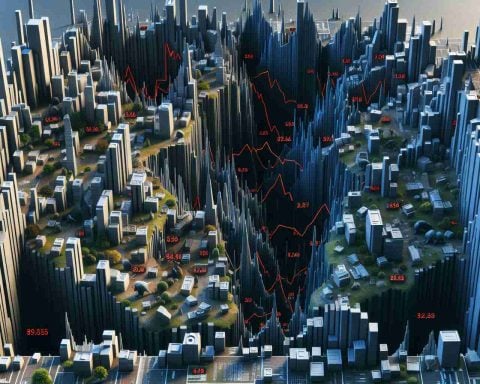- False vacuum decay describes a potential transformation of the universe into a true ground state, erasing current reality.
- Scientists recently used quantum computing, specifically a quantum annealer, to model and investigate this phenomenon.
- The study references theoretical physicist Sidney Coleman’s 1977 work, likening the universe’s potential shift to boiling water.
- Researchers from the University of Leeds used a 5564-bit quantum computer to simulate bubble growth and interactions.
- The experiment highlights quantum computing’s capability to explore complex cosmic questions previously deemed incomprehensible.
- The findings indicate that while the universe currently remains stable, quantum computing advances our understanding of possible cosmic transformations.
Imagine a universe that vanishes not with fiery explosions but a silent transformation, a gentle whisper into oblivion. This is the enigmatic world of “false vacuum decay,” a concept where the very fabric of our universe could shift to a true ground state, triggering cosmic bubbles that expand and wipe out what we know.
In a recent breakthrough, scientists harnessed the power of a quantum computer to explore this cosmic enigma. With a device known as a quantum annealer, they modeled the birth and growth of these bubbles, ushering in new insights into a phenomenon once thought too vast to comprehend.
The journey began with the work of theoretical physicist Sidney Coleman in 1977, who suggested our universe is akin to a pot of water on the verge of boiling over into another state. While the odds of such a transformation are unknown—and potentially aeons away—it remains a tantalizing possibility.
Researchers from the University of Leeds dove deep, utilizing a 5564-bit quantum computer to simulate how these bubbles might grow and interact. Their findings offer a tantalizing glimpse of what quantum technology can achieve, extending beyond theoretical physics into the realm of practical experimentation.
The results are as fascinating as they are profound. Despite the terrifying implications, the experiment showcases how quantum computing can decipher the universe’s most elusive secrets.
The key takeaway? While our universe remains stable for now, the innovative use of quantum computing propels our understanding of cosmic phenomena into new frontiers. So, for those pondering the universe’s fate, know that the answers may lie not just in the stars, but in the quantum bits that decipher cosmic enigmas.
The Silent Collapse: Could Quantum Computers Predict the Universe’s Fate?
## The Mysterious World of False Vacuum Decay
In exploring cosmic mysteries, the concept of “false vacuum decay” presents a captivating scenario where our universe might silently transition into a new state. Unlike dramatic endings filled with fiery blasts, this transformation suggests a whisper into oblivion, as described above. But how solid is this theory, and what are its broader implications?
## The Power of Quantum Computing in Unraveling the Universe
Recent advancements in quantum computing, particularly using a device called a quantum annealer, have allowed scientists to map and model these cosmic transitions. This is a pivotal step in understanding phenomena that were once purely theoretical. The work spearheaded by the University of Leeds has taken quantum technology from abstract theory to tangible experimentation, demonstrating its potential to decode the complex fabric of our universe.
How Does This Mechanism Affect Us?
– Implications for Cosmology: If our universe is indeed a false vacuum, it raises questions about the stability of all cosmic structures. Future applications of this research could impact how we understand dark energy and the fate of galaxies.
– Technological Advancements: By employing a 5564-bit quantum computer, researchers have showcased the capability of quantum computing to tackle enormous data sets and simulate complex systems beyond traditional computers’ reach.
## The Origins and Theory
The scientifically rich idea traces back to theoretical physicist Sidney Coleman’s research in 1977. He likened the universe’s potential state change to a pot of water on the brink of boiling, ready to escape its current form. Although the likelihood and timing of such a universe-wide shift are speculative, it’s a paradigm-challenging possibility.
What Other Questions Arise?
1. How Do We Measure Quantum Events in Cosmic Terms?
Quantum events might be unpredictable and happen at scales too small to detect with conventional methods, requiring advanced technology like quantum computers for accurate simulations.
2. Can We Predict When the Transition Might Occur?
Currently, the probability and timing are unknown and potentially eons away. This leads scientists to focus on understanding the mechanics rather than forecasting imminent changes.
## The Road Ahead: Cosmic Exploration Through Quantum Lenses
This breakthrough does more than tantalize the imagination; it represents a leap in utilizing quantum computing to explore cosmic phenomena. A universe that might one day be on the brink of transformation invokes both fear and fascination. Nonetheless, quantum computing advanced our understanding of these cosmic riddles and offers us new tools to explore them.
## Suggested Links
For more information on cosmology and recent scientific discoveries, explore the following resources:
– Quanta Magazine
– Scientific American
– Nature
These platforms provide credible and in-depth articles about the universe, the role of quantum technology, and scientific advancements shaping our understanding of everything around us.













